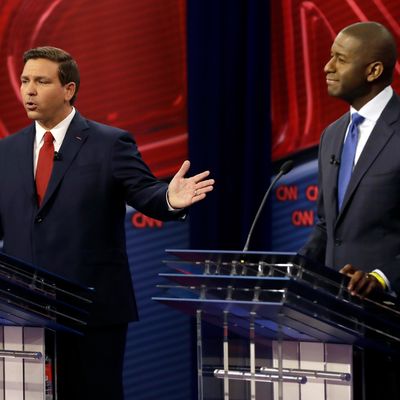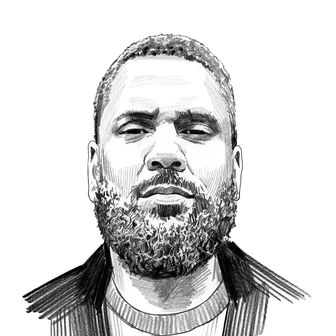
Crime has been a focal point of the Florida governor’s race. Ron DeSantis and his most famous surrogate, President Donald Trump, have sought repeatedly to smear Andrew Gillum as a criminal governing a city overrun by it. “Under Mayor Gillum’s leadership, Tallahassee is the most crime-ridden city in the entire state of Florida,” DeSantis said in a debate on October 22, calling the issue “out of control.” “Andrew couldn’t keep Tallahassee safe,” he added. “You’ve had the highest crime rate in Tallahassee of all of Florida for four years,” he said in September.
DeSantis is lying. The crime rate in Tallahassee is 5,765 per 100,000 residents, according to the Associated Press, citing Florida Department of Law Enforcement data from 2017. Among cities in Florida, that does not even crack the top 25. Daytona Beach, Miami Beach, and Fort Lauderdale all rank higher.
And although crime tracking is notoriously flawed and relies on unreliable self-reporting from local officials, Tallahassee’s numbers are probably inflated. The presence of universities like Florida State and Florida A&M — home to a combined 42,000 students in a city of 191,000 residents — means people from out of state who may not list Tallahassee as their permanent residence. Nevertheless, “crimes they might commit or be victims of would be included” in the statistics, raising the crime numbers while portraying the population as lower than it is, the AP reports.
This is irrelevant to DeSantis. His attacks on Gillum are transparent attempts to scare voters into his fold as November 6 draws nearer. That it might work is a byproduct of 150 years of racist rhetoric casting black people as born criminals. Gillum’s blackness and that of his city — at 35 percent, the blackest of Florida’s ten largest — has everything to do with why DeSantis would gamble on such a verifiably false accusation. “[DeSantis] has only continued in the course of his campaign to draw all the attention he can to the color of my skin,” Gillum said in October. The day after he won the Republican nomination in August, DeSantis warned voters not to “monkey this up” by electing his black challenger. The Republican declined to return money from a wealthy white donor who called President Barack Obama a “Muslim nigger” on Twitter, claiming he had already spent it. And he has attended conferences with far-right bigots like Milo Yiannopoulos, Sebastian Gorka, and David Horowitz, while attracting members of the Proud Boys gang to his rallies. “I’m not calling Mr. DeSantis a racist,” Gillum said wryly on October 24. “I’m simply saying the racists believe he’s a racist.”
DeSantis’s conduct is emblematic, in many ways, of the contemporary Republican playbook, weaponized with particular success by Trump in his nods to white nationalists, Klansmen, and neo-Nazis. But it is not a product of it. DeSantis’s effort to link a black politician to rampant crime is part of an old and bipartisan tradition in the United States. Starting in the post-emancipation era and picking up dramatically in the 1890s, white Americans who fought on different sides of the Civil War pursued a national reconciliation campaign, the chosen enemy of which — black pathology — gave them shared meaning. Casting formerly enslaved blacks as fundamentally criminal united them in the belief that black people were congenitally unworthy of American investment. This sentiment has proven remarkably resilient over time.
“One cannot study Reconstruction without first frankly facing the facts of universal lying,” wrote W.E.B. DuBois in his landmark history, Black Reconstruction. The 15-year period beginning in mid-1860s was marked by dramatic upheavals in American society. Union troops occupied much of the fallen Confederacy to enforce the assimilation of 4 million former black slaves. Black people were granted citizenship and the right to vote under the 14th and 15th Amendments. Black officials were elected to state legislatures, school houses were built to educate black children, black churches were erected, and northern missionaries, educators, and entrepreneurs poured into the South to help establish what had the makings of a free biracial society.
But by the end of 1877, federal troops had pulled out of the region. Insurgent “Redeemers” — conservative local whites opposed to Reconstruction — rapidly assumed control. White militia and paramilitary violence targeting black ex-slaves had spread over the course of the decade, but such violence was now reified politically as federal oversight gave way to Redemption rule and Jim Crow. The preceding era was rewritten as a time of black-led hostile takeover, corruption, and plunder. “There was not a single great black leader of Reconstruction against whom almost unprintable allegations were not repeatedly and definitely made without any attempt to investigate the reliability of sources of information,” wrote DuBois.
Meanwhile, laws meant to criminalize black life proliferated across the South, as Douglas Blackmon details in Slavery by Another Name. Vagrancy statutes so vague that practically any former slave not under the care of a white man could be arrested for them had existed since 1865. But these accelerated in the 1880s. Carrying a weapon, riding on empty freight train cars, and even “speaking loudly in the presence of white women” became criminal acts. “At the end of the [decade], thousands of black men across the South were imprisoned in work camps only for violations of the new racial codes, completely subjective crimes, or no demonstrable crime at all,” Blackmon writes.
Around the same time, white sociologists and scholars began debating in earnest why so many crimes seemed to be committed by black people. The conclusion reached by many — including the most popular and influential among them, like Frederick L. Hoffman, author of the 1896 book Race Traits and Tendencies of the American Negro — was that black crime was a result of black people’s inherent mental and cultural deficiencies. They used statistics to legitimize age-old white-supremacist narratives about black defect. They saw disproportionately high black incarceration rates as proof black people committed more crimes, with little attempt to honestly assess their root causes. Blacks were unfavorably compared to poor whites in the South and immigrants from Italy and Ireland in the North, who purportedly faced living conditions “fully as bad as for the blacks,” according to Khalil Gibran Muhammad’s The Condemnation of Blackness. “The difference is racial … What can be done?” wrote University of Chicago anthropologist Frederick Starr in 1897. “Less petting and more disciplining is needed.”
Such punitive rhetoric was rarely applied to white criminals. “White criminality was society’s problem,” rooted in issues like insufficient economic opportunities, writes Muhammad. “[Black] criminality was black people’s problem.” And this attitude was transferred into divergent ideas about how public policy should address each community. “Among whites, struggling neighborhoods were considered a cause of crime and reason to intervene. Among blacks, they were considered a sign of pathology and reason for neglect.”
That black Americans had spent two centuries as slaves only to be forced into the precise kind of degraded conditions that breed crime — concentrated poverty, precarious employment, and steady violence against them by a racist citizenry and government, including the invention of criminal statutes designed to target them — went largely ignored. White reunification after the Civil War took precedent over black equality. Black crime was now a lens through which whites could understand the meaning of black freedom — and ultimately decide it was often not worth the trouble. In the meantime, many white southerners felt vindicated in their long-held racist views. “[Black] criminality brought out the worst in everyone,” argued the likes of Thomas Nelson Page, a Virginia lawyer, writer, and future U.S. ambassador to Italy, writes Muhammad. “With ten million Negroes within its borders, the South needed understanding, not repudiation, from the North.”
Black criminality serves a similar unifying purpose today. It was no accident that then-presidential candidate Bill Clinton staged a campaign event in 1992 at the base of Georgia’s Stone Mountain, the most recognizable Confederate monument in the country. Arrayed behind him was a neat formation of inmates from a local correctional facility, almost all of whom were black. The message was clear — that despite being a Democrat at a time when the party was trying to reverse its “soft on crime” reputation, Clinton could be as iron-fisted with black criminals as any Republican. And it is no accident that “black-on-black crime” is the canard invoked most frequently by those seeking to avoid confronting law enforcement racism. Once viewed as a reason for self-criticism and self-improvement among black people, it is now weaponized, usually by whites, to argue they do not deserve structural investment. “I find it very disappointing that you’re not discussing the fact that 93 percent of blacks in America are killed by other blacks,” former New York City mayor and Trump lawyer Rudy Giuliani told NBC in 2014, responding to questions about how to make police departments less biased.
Ron DeSantis understands how appealing this rhetoric is. He understands, as Muhammad observes, that “crime rates in the nation’s biggest cities are generally understood as a reflection of the presence and behavior of the black men, women, and children who live there.” He understands that he is neck-and-neck in polls with a black man in Florida, a state where fear and hostility toward black men and children has repeatedly led to their violent deaths at the hands of vigilantes. He knows this fear is his ally if he hopes to win. At a September press conference, more than a week after winning the primary, DeSantis’s campaign informed reporters who sought to question him about his platform that he needed “time to flesh [it] out” first. That he had gotten so far without a platform is a testament to the power of his emotional appeals — that being a white, Trump-supporting Republican, and a bulwark against a harbinger of black crime might be enough.
DeSantis understands history, whether consciously or intuitively. By lying to exaggerate crime under Gillum’s mayoralty, he is capitalizing on the deep-seated belief that black Americans are fundamentally tied to crime, and as a result are viewed as unworthy of investment, deserving of punishment, and their claims of mistreatment illegitimate. Broadly speaking, the framing of this issue shifts with the day’s passions, as when it is cast by conservatives as a failure of Democratic leadership rather than explicitly racial. Yet the unseriousness of Republican solutions — namely, more and harsher policing — and the blackness of the highlighted citizenry, as in Tallahassee and Chicago, betray the roots of their argument. A black progressive mayor is an obvious bogeyman for conservatives and racists, and DeSantis is both, fighting to prolong 19 years of white Republican rule in the Florida statehouse. Tying Gillum to crime is not just a natural political strategy. It is tradition.






























